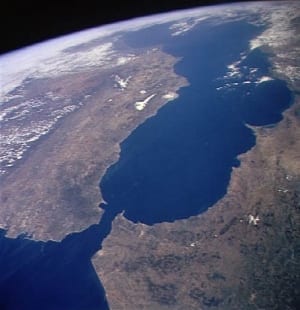
Less than eight nautical miles wide, the Strait of Gibraltar is an easily surmountable barrier between northwest Africa and Spain. Military invaders such as Hannibal of Carthage and the caliphs of the Islamic Empire have had no trouble traversing this sliver of sea in the process of invading Europe.
But in addition to those legendary military campaigns, countless unsung migrants have also crossed between the two continents via the so-called “Pillars of Hercules.” In fact, archaeologists have long speculated that people have been moving across the Strait — in both directions — for thousands of years. Recently, genetics has also supported a prehistoric connection between the two continents.
Though most scientists who study North African genetics have focused their attention on connections to the Near East, recent studies have shown that the majority of North African genetic types, or haplogroups, suggest European ancestry. The most recent evidence comes from a team of geneticists on both sides of the Mediterranean who collected samples from from more than 300 people living throughout Tunisia and analyzed their mitochondrial DNA (mtDNA). Passed directly by mothers to their offspring, mtDNA traces ancestry back thousands of years along an exclusively maternal line.
The researchers were especially interested in so-called ‘Andalusians,’ who are descended from Spanish Muslims, or Moors, who were expelled from Spain in the 16th and 17th centuries after the Reconquista and Inquisition. Because the ancestors of the Andalusians came to Spain from North Africa with the Muslim invasions of the 8th century, only to return to North Africa 900 years later, the researchers hoped their mtDNA might reveal a very interesting pattern of genetic ancestry.
After analyzing the mtDNA samples, the authors noticed some very interesting results indeed. Most of the samples belonged to the very diverse and distinctly European haplogroup H. In some Tunisian communities nearly 45% of individuals belonged to that haplogroup.
Because haplogroup H is so diverse and widespread across Europe, the authors wanted to dig a bit deeper to find out if they could pinpoint the origin of the Tunisian haplogroup H lineages. They found that the most common sub-groups of haplogroup H in Tunisia were most commonly found in Western Europe, specifically Spain and Portugal. The sub-groups of H most often found in Eastern Europe and the Near East, on the other hand, were quite rare. Further analysis showed that people bearing these sub-H groups almost certainly entered North Africa via the Strait of Gibraltar.
The authors speculate that the migration occurred after the end of the Ice Age, perhaps 10,000 years ago. At that time, people began streaming out of the Iberian peninsula, where they had been confined for millennia by the mile-thick sheet of ice that covered northern and central Europe. These results show that — even before invading armies crossed the Strait of Gibraltar heading north, people carrying the H haplogroup passed through in the opposite direction.
But what about the Andalusians? Does their mtDNA distinguish them from other Tunisians? Can we see any genetic footprints of their recent expulsion from Iberia? Even after examining the mtDNA of Andalusians in fine detail, the authors were unable to distinguish them from other North African communities. It appears that the majority of the European influence on the genetics of North Africans occurred many thousands of years ago, when glaciers began to retreat and people expanded from Spain; both north into the heart of Europe, and south into Africa.